Battle of the Bzura
The Battle of the Bzura (or the Battle of Kutno) was the largest Polish counter-attack[3] of the German Invasion of Poland, fought between the 9th and 19 September.[4][5] The battle took place west of Warsaw, near the Bzura River. It began as a Polish counter-offensive, which gained initial success, but the Germans outflanked the Polish forces with a concentrated counter-attack. This weakened Polish forces and the Poznań and Pomorze Armies were destroyed. Western Poland was now under German rule.[6]: 65–70 The battle has been described as "the bloodiest and most bitter battle of the entire Polish campaign".[7] Winston Churchill called the battle an "ever-glorious struggle".[8]
| Battle of the Bzura | |||||||
|---|---|---|---|---|---|---|---|
| Part of Invasion of Poland, World War II | |||||||
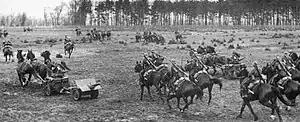 Polish cavalry brigade "Wielkopolska" during the battle | |||||||
| |||||||
| Belligerents | |||||||
|
|
| ||||||
| Commanders and leaders | |||||||
|
|
| ||||||
| Strength | |||||||
|
12 infantry divisions 5 armoured and motorized divisions 425,000 soldiers[1] |
8 infantry divisions 2–4 cavalry brigades 225,000 soldiers[1] | ||||||
| Casualties and losses | |||||||
|
8,000 dead[2] 4,000 captured 50 tanks 100 cars 20 artillery pieces |
18,000[2]–20,000[1] dead 32,000 wounded[2] 170,000 captured[2] | ||||||
Background

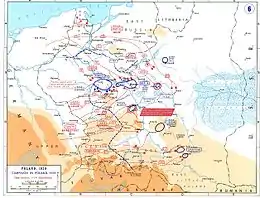
The Polish plan for defense against the German invasion, Plan West, called for the defense of the borders.[9] This was dictated more by political than military concerns, as Poles feared that the Germans, after taking over territories they lost in the Treaty of Versailles, would try to end the war and keep those territories.[1] While defending the borders was riskier, the Poles were counting on the British and French counteroffensive (that never came).[1] Due to this, Army Pomorze under general Władysław Bortnowski found itself in the Polish Corridor, surrounded by German forces on two fronts, and Army Poznań under general Tadeusz Kutrzeba was pushed to the westernmost fringes of the Second Polish Republic, separated both from its primary defensive positions and from other Polish Armies.[1]
The German offensive proved the folly of the border defense plan in the first days of the war.[10] Army Pomorze was defeated in the battle of Bory Tucholskie, and forced to retreat towards the south-east.[10] Army Poznań, meanwhile, although not facing heavy German assaults, was forced to retreat east due to defeats of its neighbours (Army Pomorze in the north and Army Łódź in the south); both of them were retreating, meaning that Army Poznań was in danger of being flanked and surrounded by the German forces.[10] On 4 September, Army Poznań moved through Poznań and abandoned it to the enemy, although at this point it was not in contact with any significant German forces.[10] By 6 September, Armies Pomorze and Poznań had linked, forming the strongest Polish operational unit in the campaign, and general Bortnowski accepted the command of general Kutrzeba.[10]
On 7 September, Polish forces became aware of the German push towards Łęczyca, which if successful could cut off the retreat route of Polish forces.[10] By 8 September, advanced German troops reached Warsaw, marking the beginning of the 1939 siege of Warsaw.[10] At the same time, German forces had lost contact with Army Poznań, and German command assumed that the army must have been transported by rail to aid Warsaw's defense; they were unaware that in fact Army Poznań had merged forces with Army Pomorze, which they considered, since its defeat at Bory Tucholskie, no longer a significant threat.[10] On 8 September the Germans were certain that they had eliminated major Polish resistance west of Vistula and were preparing to cross it and engage the Polish forces on the other side.[2]
Meanwhile, general Kutrzeba and his staff officers had suspected, even before the German invasion, that it would be the neighbouring Armies that would bear the German attack, and had developed plans at an offensive towards the south, to relieve Army Łódź.[11] In the first week of the campaign, those plans, however, were rejected by the Polish commander-in-chief, Marshal Edward Rydz-Śmigły.[11] By 8 September Kutrzeba had lost contact with Rydz-Śmigły, who had relocated his command center from Warsaw to Brest; due to these factors, Kutrzeba decided to go forward with his plan.[11] His situation was dire, as German forces were close to surrounding his units: the German 8th Army had secured the southern bank of the Bzura river and the German 4th Army had secured the northern bank of Vistula, from Włocławek to Wyszogród, and its elements were attacking the rear of the Armies Pomorze and Poznań from the direction of Inowrocław and crossing the Vistula river near Płock.[11]
Opposing forces
Polish forces consisted of Army Poznań and Army Pomorze.[1] German forces included the 8th Army under Johannes Blaskowitz and 10th Army under Walther von Reichenau of Army Group South (Heeresgruppe Süd), elements of the 4th Army under Günther von Kluge of the Army Group North (Heeresgruppe Nord) and air support (Luftflotte 1 and Luftflotte 4).[1]
| Polish | |||||||||||||||||||||||||||
|---|---|---|---|---|---|---|---|---|---|---|---|---|---|---|---|---|---|---|---|---|---|---|---|---|---|---|---|
|
| German | |||||||||||||||||||||||||||||||||||||||||||||||||||||||||||||||||||||||||
|---|---|---|---|---|---|---|---|---|---|---|---|---|---|---|---|---|---|---|---|---|---|---|---|---|---|---|---|---|---|---|---|---|---|---|---|---|---|---|---|---|---|---|---|---|---|---|---|---|---|---|---|---|---|---|---|---|---|---|---|---|---|---|---|---|---|---|---|---|---|---|---|---|---|
|
Battle
The battle can be divided into 3 phases:
- Phase I — Polish offensive towards Stryków, aiming at the flank of the German 10th Army (9–12 September)[1]
- Phase II — Polish offensive towards Łowicz (13–15 September)[1]
- Phase III — German counterattack and eventual defeat of the Poles, with the latter's withdrawal towards Warsaw and
Modlin (16–19 September)[1]
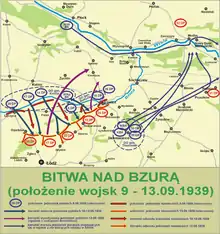
On the night of 9 September, the Polish Poznań Army commenced a counterattack from the south of the Bzura river, its target being the German forces from the 8th Army advancing between Łęczyca and Łowicz, towards Stryków.[12][13] The commander of Poznań Army, Tadeusz Kutrzeba noticed that the German 8th Army, commanded by general Johannes Blaskowitz, was weakly secured from the north by only the 30th Infantry Division stretched over a 30 kilometre defensive line while the rest of the army was advancing towards Warsaw. The main thrust of the Polish offensive were the units under general Edmund Knoll-Kownacki, known as the Knoll-Kownacki Operational Group (Polish 14th, 17th, 25th and 26th Infantry Divisions).[12][13][14] The right wing of the offensive, in the area Łęczyce, included the Podolska Cavalry Brigade under Col. L. Strzelecki, and on the left, advancing from Łowicz to the area of Głowno, the Wielkopolska Cavalry Brigade under general Roman Abraham.[12][13][15] These groups inflicted considerable losses on the German defenders from the 30th Infantry Division and the 24th Infantry Division, with some 1,500 German soldiers killed or wounded and an additional 3,000 lost as prisoners during the initial push.[12][13][16] The cavalry brigades supplemented with TKS and TK-3 reconnaissance tanks moved to threaten the flanks and rear of the advancing German units.[17]
The German forces were thrown back approximately 20 kilometres and the Poles recaptured several towns, including Łęczyca and Piątek, and the village of Góra Świętej Małgorzaty.[12] On 10 September, the Polish 17th Infantry Division met the German 17th Infantry Division at Małachowicze. The following day Polish forces continued their attack, advancing on Modlna, Pludwiny, Osse and Głowno.[12]
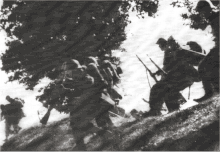
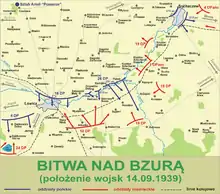
Initially underestimating the Polish advance, the Germans decided on 11 September to redirect the main force of the German 10th Army, the German 4th Army, the reserves of the Army Group South, and aircraft from 4th Air Fleet towards the Bzura. These forces included the German 1st Panzer Division, German 4th Panzer Division and the newly formed SS Infantry regiment Leibstandarte Adolf Hitler.[18] German air superiority had a significant impact, making it very costly and difficult for the Poles to move units during the day.[13] The following day the Poles reached the line Stryków-Ozorków. That day General Tadeusz Kutrzeba learned that units of Army Łódź had retreated to the Modlin Fortress, and decided to stop the offensive, instead looking to try to break through Sochaczew and the Kampinos Forest to reach Warsaw.[13][18]
On the morning of 14 September, General Władysław Bortnowski's 26th and 16th Infantry Divisions crossed the Bzura near Łowicz. The Polish 4th Infantry Division reached the road linking Łowicz with Głowno. At this point however, Bortnowski ordered the 26th Infantry Division to retreat. He had learned of the withdrawal of the German 4th Panzer Division from the outskirts of Warsaw, and was concerned that this Panzer division posed a threat to his men.[18]
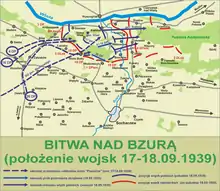

On 15 and 16 September, Army Pomorze took up defensive positions on the north bank of the Bzura. General Stanisław Grzmot-Skotnicki's group was between Kutno and Żychlin, General Michał Karaszewicz-Tokarzewski's units near Gąbin, and parts of Army Poznań by the Bzura near Sochaczew, were ready to begin their drive towards Warsaw. To encircle and destroy the Polish forces, the Germans used most of their 10th Army, including two armoured, one motorized, and three light divisions, equipped with some 800 tanks altogether. The attack from all sides on Polish positions started on 16 September, with the support of the Luftwaffe. On 15 September Poles were forced out of Sochaczew, a town on the Bzura river, and trapped in a triangle of Bzura, Vistula and German forces.[13][19] The German 1st Panzer Division, after crossing the Bzura between Sochaczew and Brochów and engaging the Polish 25th Infantry Division managed to capture Ruszki, but its advance was then halted. Poles began to cross the Bzura near the Vistula, north of Sochaczew, and retreat towards Warsaw.[13][19][20] Polish forces were forced to abandon most of their heavy equipment while crossing the river.[19] On 17 September, German heavy artillery was shelling the crossing north of Brochów, and the largest air operation of the campaign began, with the Luftwaffe attacking the retreating Polish forces.[13][19]
During the night of 17 September, the main forces of Army Poznań attacked the German forces in order to break out of the German encirclement between Witkowice and Sochaczew. The 15th Infantry Division and Podolska Cavalry Brigade again crossed the Bzura in Witkowice. In Brochow, the 25th and 17th Infantry Divisions crossed the Bzura river. The 14th Infantry Division was concentrated in Łaziska. At the same time, Army Pomorze marched towards the villages of Osmolin, Kierozia and Osiek.
In the morning the Germans started their drive towards the south along both banks of the Bzura, supported by more than 300 aircraft and heavy artillery.[19] German howitzers, taking advantage of their position on the high ground of the Vistula's right bank, shelled Polish positions for the entire day.[19] And after two days of heavy fighting, with no ammunition or food rations remaining, further attempts at a breakout for the Poles became impossible.[9]
Aftermath

"[My soldiers fought] in one of the biggest and most destructive battles of all times."
Only a few Polish units managed to break out of the encirclement.[19] These groups entered Warsaw and Modlin, mostly around 19 and 20 September, crossing the Kampinos Forest, and fighting German units in the area (for example, in the battle of Wólka Węglowa).[13][21] Among them were Generals Kutrzeba, Knoll-Kowacki and Tokarzewski, two cavalry brigades (Wielkopolska and Podolska) of General Abraham, and the 15th and 25th Infantry Divisions. The remainder (4th, 14th, 17th, 26th and 27th Infantry Divisions), which didn't manage to cross the river, with General Bortnowski, capitulated between 18 and 22 September.[2][13] Polish casualties were estimated at 20,000 dead, including three generals: Franciszek Wład, Stanisław Grzmot-Skotnicki and Mikołaj Bołtuć.[1] German casualties are estimated at 8,000 dead.[2]
After the battle the remaining German divisions rushed towards Warsaw and Modlin and soon encircled both. The Bzura campaign ended in defeat for the Poles but because of the initial Polish local successes the German advance on Warsaw was halted for several days. The Wehrmacht was required to divert units from its push towards Warsaw.[22] This enabled the Polish units defending Warsaw and its environs to better organize their own long-term, but ultimately failed, defense of the capital.[23]
The campaign also showed the importance of taking initiative, proved that horse cavalry units were still an important factor on the battlefield, proved the importance of air superiority and confirmed that simple numerical superiority did still matter.[1][24]
See also
- List of World War II military equipment of Poland
- List of German military equipment of World War II
Notes
- Cisowski, Zalewski, Bitwa..., p.14
- "Wojna Światowa". Historia Polski. Archived from the original on 31 December 2007. Retrieved 24 August 2008.
- David T. Zabecki (1 May 2015). World War II in Europe: An Encyclopedia. Routledge. pp. 1665–. ISBN 978-1-135-81242-3.
- The Second World War: An Illustrated History , Putnam, 1975, ISBN 0-399-11412-2, Google Print snippet (p.38)
- Sources vary regarding the end date, some giving 18 September while others 19 September. Brockhaus Multimedial Lexikon gives 19 September 1939 as the battle's end date.
- Zaloga, S.J., Poland 1939, Oxford, Osprey Publishing Ltd., 2002, ISBN 9781841764085
- Donald A. Bertke; Gordon Smith; Don Kindell (1 March 2011). WORLD WAR TWO SEA WAR. Lulu.com. pp. 67–. ISBN 978-0-578-02941-2.
- Winston Churchill, The Gathering Storm, vol. 1 of The Second World War (Boston: Houghton Mifflin, 1948), p. 445. Churchill gives "the battle of the river Bzura" as its name.
- Seidner, Stanley S. Marshal Edward Śmigły-Rydz Rydz....,34-128.
- Cisowski, Zalewski, Bitwa..., p.5
- Cisowski, Zalewski, Bitwa..., p.6
- Cisowski, Zalewski, Bitwa..., p.8
- Cisowski, Zalewski, Bitwa..., p.11
- Seidner, Stanley S. Marshal Edward Śmigły-Rydz Rydz...., 120-22.
- Seidner, Stanley S. Marshal Edward Śmigły-Rydz Rydz....,124.
- Elble Rolf, 1975, Die Schlacht an der Bzura im September 1939 aus deutscher und polnischer Sicht
- Seidner, Stanley S. Marshal Edward Śmigły-Rydz Rydz....,124-125.
- Cisowski, Zalewski, Bitwa..., p.9
- Cisowski, Zalewski, Bitwa..., p.10
- Seidner, Stanley S. Marshal Edward Śmigły-Rydz Rydz....,127.
- Cisowski, Zalewski, Bitwa..., pp.12–13
- Seidner, Stanley S. Marshal Edward Śmigły-Rydz Rydz....,128.
- Seidner, Stanley S. Marshal Edward Śmigły-Rydz Rydz....,128-129.
- Andrzej Kunert in "Wrzesień 1939 9/19 - Bzura" claims that at least one pivotal attack was cancelled because, while marching, the soldiers were asleep because they have not slept for a few days. This led to the loss of momentum. URL:https://www.youtube.com/watch?v=x5QLw_zyMgo .
References
- (in Polish) Sławomir Cisowski, Wojciech Zalewski, Bitwa nad Bzurą, Chwała Oręża Polskiego 26 (47), Rzeczpospolita, 20 January 2007 (publication contains a map of the battle).
- Stanley S.Seidner, Marshal Edward Śmigły-Rydz Rydz and the Defense of Poland, New York, 1978.
External links
- Juliusz Tym (2005). "Kawaleria w bitwie nad Bzurą (Cavalry in the Battle of Bzura)" (in Polish). Polonia Militaris. Archived from the original on 27 September 2007. Retrieved 24 August 2007.